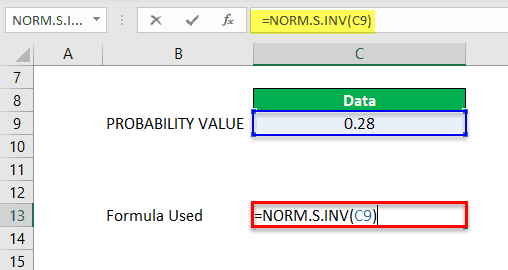Table Of Contents
NORM.S.INV() Function in Excel
It is a pre-built integrated function in Excel that is categorized under statistical functions in Excel. The NORM.S.INV Excel function is the latest updated version with improved accuracy compared to the older version of this Excel function.

- The normal distribution is the most widely used in statistics. It is also called a “Bell curve” or “Gaussian curve.”
- We can fully describe the normal distribution based on its mean and standard deviation (SD) values.
- A normal distribution is called "standard normal distribution" when its mean value is “0” or zero, and the standard deviation value is equal to 1.
The normal distribution can be standardized by using the below-mentioned formula:
z = (x - mean)/ sd

Z value on the x-axis is the standard normal deviation. Here, the red arrowed line in the curve indicates where the standard deviation of the mean value is within 1, whereas the green arrowed line in the curve indicates where the standard deviation of the 0mean value is within 2.
Definition of NORM.S.INV Excel Function
The NORM.S.The INV Excel function is used to determine or calculate the inverse normal cumulative distribution for a given probability value.
It returns the inverse of the standard normal cumulative distribution. The distribution has a mean of zero and a standard deviation of one.
Given the probability that a variable is within a certain distance of the mean, it calculates the z value (standard normal deviate), where it corresponds to an area under the curve.
Usually, the area should be between 0 and 1.
The z value (standard normal deviate) corresponds to a one-tailed probability P.
Where P value must be between 0 and 1 (0<P<1).
NORM.S.INV Formula in Excel
The syntax or formula for the NORM.S.INV function in Microsoft Excel is:

Its syntax or formula has the below-mentioned argument:
Probability: (Compulsory or required parameter) It is a probability corresponding to the normal distribution.
It is the inverse of the NORM.S.DIST function.
How to Use NORM.S.INV Function in Excel?
Let us look out how the NORM.S.INV Excel function works in Excel.
Example #1 - A Probability (P) Value Less Than 0.5
In the below-mentioned example, we have a dataset in a cell “C9,” 0.28, which is a probability value.

Here, we need to find the approximate value of the inverse of the standard normal cumulative distribution using NORM.S.INV Excel FUNCTION.
Let us apply this function in cell “C13”. But, first, select the cell “C13.”

Click the insert function button (fx) under the formula toolbar.

A dialogue box will appear.

Type the keyword “NORM” in the search for a function box; various standard normal cumulative distribution equations appear. In that, select NORM.S.INV Excel function.

Probability: It is a probability corresponding to the normal distribution. Here, it is 0.28.

Click "OK," after inserting the probability argument= NORM.S.INV (0.28).

It returns the approximate inverse value of the standard normal cumulative distribution or standardized normal deviate, -0.582841507.

Example #2 - A Probability (P) Value More Than 0.5
In the below-mentioned example, we have a dataset in a cell “B22,” 0.88, which is a probability value.

Here, we need to find the approximate value of the inverse of the standard normal cumulative distribution using NORMSINV() FUNCTION.
Let us apply this function in cell “B26”. But, first, select the cell “B26.”

Click the "insert function" button (fx) under the "Formulas" toolbar.

A dialog box will appear.

Type the keyword “NORM” in the search for a function box; various standard normal cumulative distribution equations appear. In that, select NORM.S.INV() function.

Double click on the function. A dialog box appears where arguments must be filled or entered, i.e., =NORM.S.INV (probability).
Probability: It is a probability corresponding to the normal distribution. Here, it is 0.88.

Click "OK" after entering the probability argument, =NORM.S.INV(0.88).

It returns the approximate inverse value of the standard normal cumulative distribution or standardized normal deviate, 1.174986792.

Example #3 - A Probability (P) Value of 0.51
In the below-mentioned example, we have a dataset in a cell “B32,” 0.51, which is a probability value.

Here we need to find the approximate value of the inverse of the standard normal cumulative distribution using the NORM.S.INV() FUNCTION.
Let us apply this function in cell “B37”.

Click the "Insert Function" button (fx) under the "Formulas" toolbar.

A dialogue box will appear.

Type the keyword “NORM” in the search for a function box; various standard normal cumulative distribution equations appear.

Probability: It is a probability corresponding to the normal distribution. Here, it is 0.51.

Click ok, after entering the probability argument = NORM.S.INV(0.51)

It returns the approximate inverse value of the standard normal cumulative distribution or standardized normal deviate, 0.025068908.

Things to Remember About The NORMSINV() Function in Excel
The most common errors in excel in this function is #NUM! Error and #VALUE! Error.
1. #NUM! Error
#NUM! Error occurs when the given probability argument is less than zero (negative values) or equal to zero or greater than one.
In the below-mentioned table, the cell “B41” value numeric value is 0. But, suppose we apply the NORM.S.INV function, it returns a #NUM! Error.

Similarly, suppose we apply NORM.S.INV() function on the values 1.5 and -1.5 in the cells B42 and B43. It returns a #NUM!Error.

2. #VALUE! Error
#VALUE! Error occurs if any of the given arguments is text value or non-numeric.
In the table below, cell “B24” contains a text value, the word “TEXT.” Now, if we apply NORM.S.INV Excel function to find out the approximate value of the inverse of the standard normal cumulative distribution; It returns #VALUE! Error.

The precision or accuracy of these function values depends on the accuracy of NORM.S.INV and NORM.S.DIST. values. It uses an iterative search technique.

